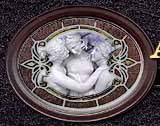|
Literary Commentary: Sympathy for the Dwarfe
In the first four cantos of Edmund Spenser's remarkable work The Faerie Queene, I was
intrigued with Spenser's serious use of allegory in his tightly structured stanzas. It seems as
if every character he describes has a reflection in the reality of his time. The heroic knight
Redcrosse is representative of the holiness of the Christian Englishman, striving against evil
and temptation; Una is the truth for which the Christian man searches; Queen Gloriana and
Britomart are flatteries of Queen Elizabeth; Archimago is the corrupted Roman Catholic Church.
Even the Biblical Deadly Sins are anthropomorphized and animalized (wonderfully distinctly, in my
opinion; Spenser's choices of steed for each of the "Queen's" counselors are perfectly apt).
The presence of Satan as Pride's carriage driver seems one of the few literal inclusions in the
work.
However, the presence of the Dwarf, his service to the Lady Una, and his accompanying Redcrosse
after Archimago's illusions, sparked my interest, because I am unaware of any allegorical
connection for him. At first he is merely an uncomplaining pack mule trailing behind her lowly
ass, a carrier of Una's necessities, and also an arms-carrier for the good Knight. Initially I
thought him the Lady's servant, with the occasional helpful advice and extra hand for Redcrosse,
but when he left with Redcrosse after the archmage's treachery, I wondered under whose service he
was. I understand he is given more to do after Book 1, Canto 4, in discovering the captive souls
underneath Pride's castle, and he is a faithful servant throughout Redcrosse's and Una's
adventures. Is the Dwarf meant to represent a person or a concept of Spenser's time? Is he just
a nameless character to help support the two protagonists? Is he meant as a possible representation
of humanity's shrinking doubt and fear?
I read the tale of the Knight's battle against Errour, and was struck by how potentially terrifying
this must have been to the readers of the day. This is, after all, a fairly imaginative monster,
and the depiction of its blasphemous young, her poison, and the deaths of her and her spawn is
alarming (which means I like it a great deal). Then again, painters like Bosch and Bruegel the
Elder were able to conceive of visual nastiness to rival our modern imagination.
I also wondered somewhat, because in researching The Faerie Queene I noticed that
Redcrosse is meant to be St. George. Before entering the shady grove and going against Una's and
the Dwarf's warnings to enter Errour's lair, he hands his spear to the Dwarf (as it is supposed
to be useless on foot according to the notes). Yet it struck me that every representation of St.
George of which I am aware depicts him as slaying the dragon underfoot with a spear, whether
ahorse or afoot. While this battle is meant to reflect that famous one of England's patron saint, I
wondered why a spear was thought to be useless on foot, unless by "spear" Spenser means "lance."
It was a small note, but as one interested in medieval and renaissance weaponry I enjoy absorbing
the martial details that writers choose to include.
For Reference:
Spenser's The Faerie Queene
David Elsensohn, March 2005
Return to Essays
|

